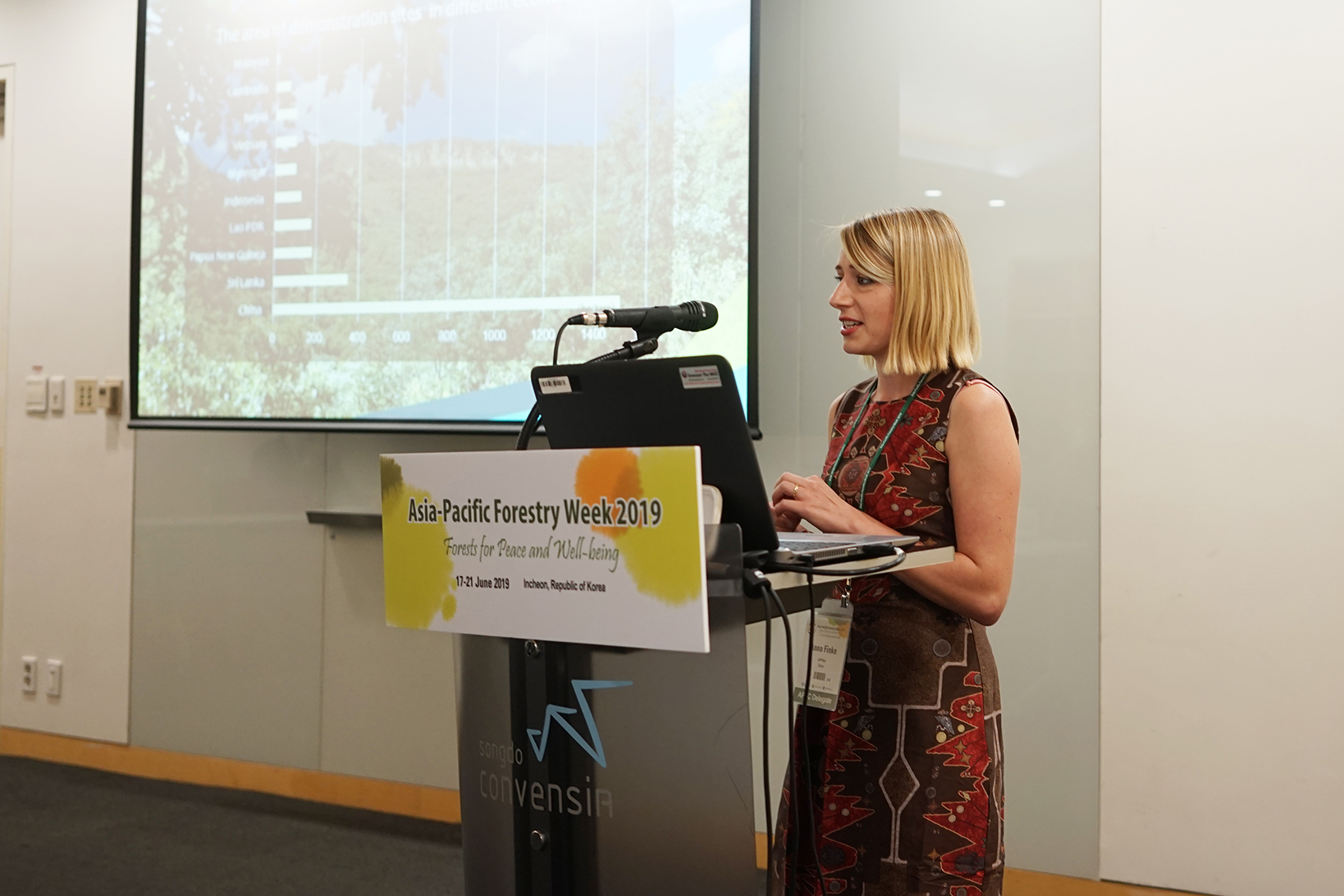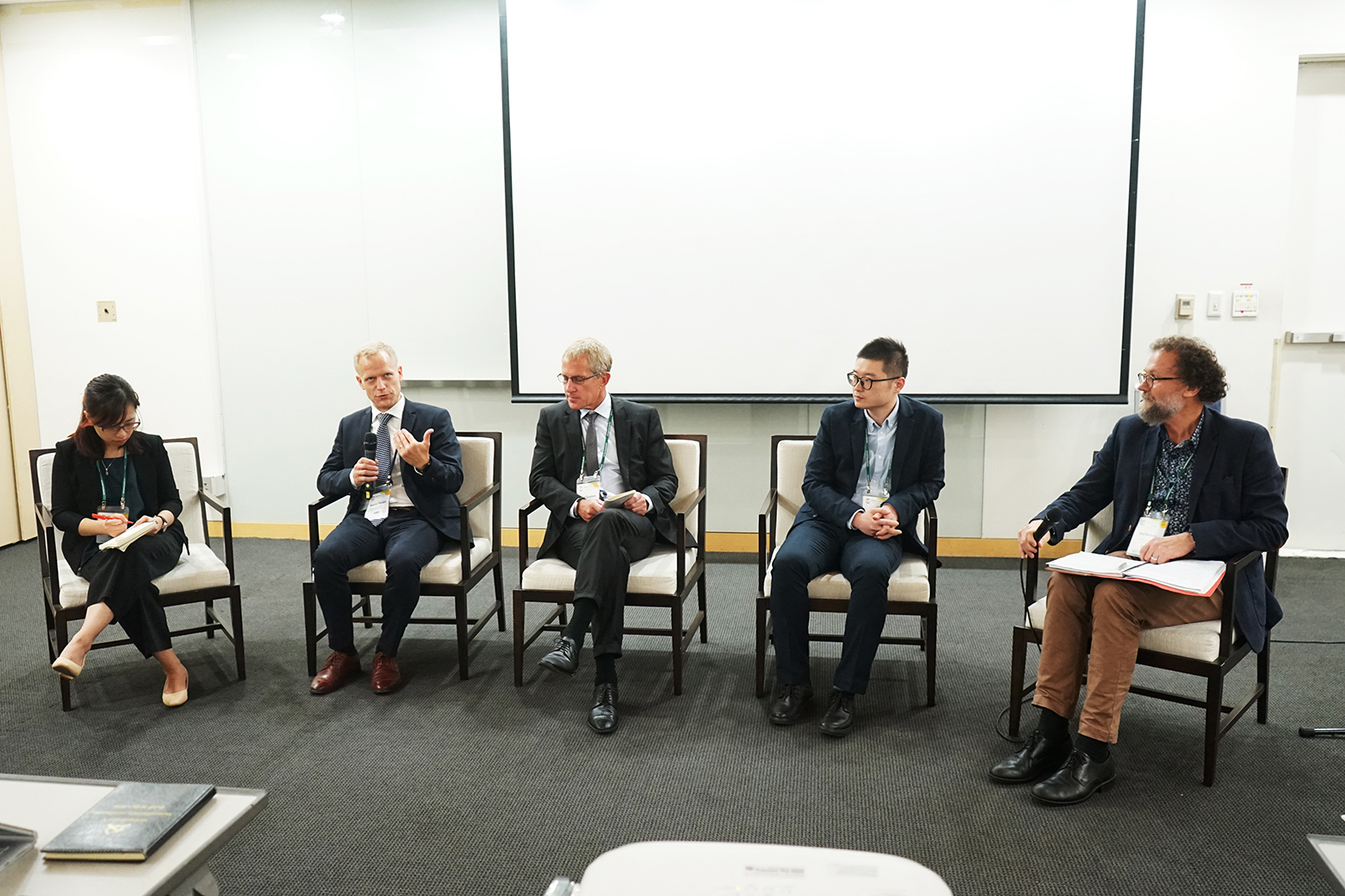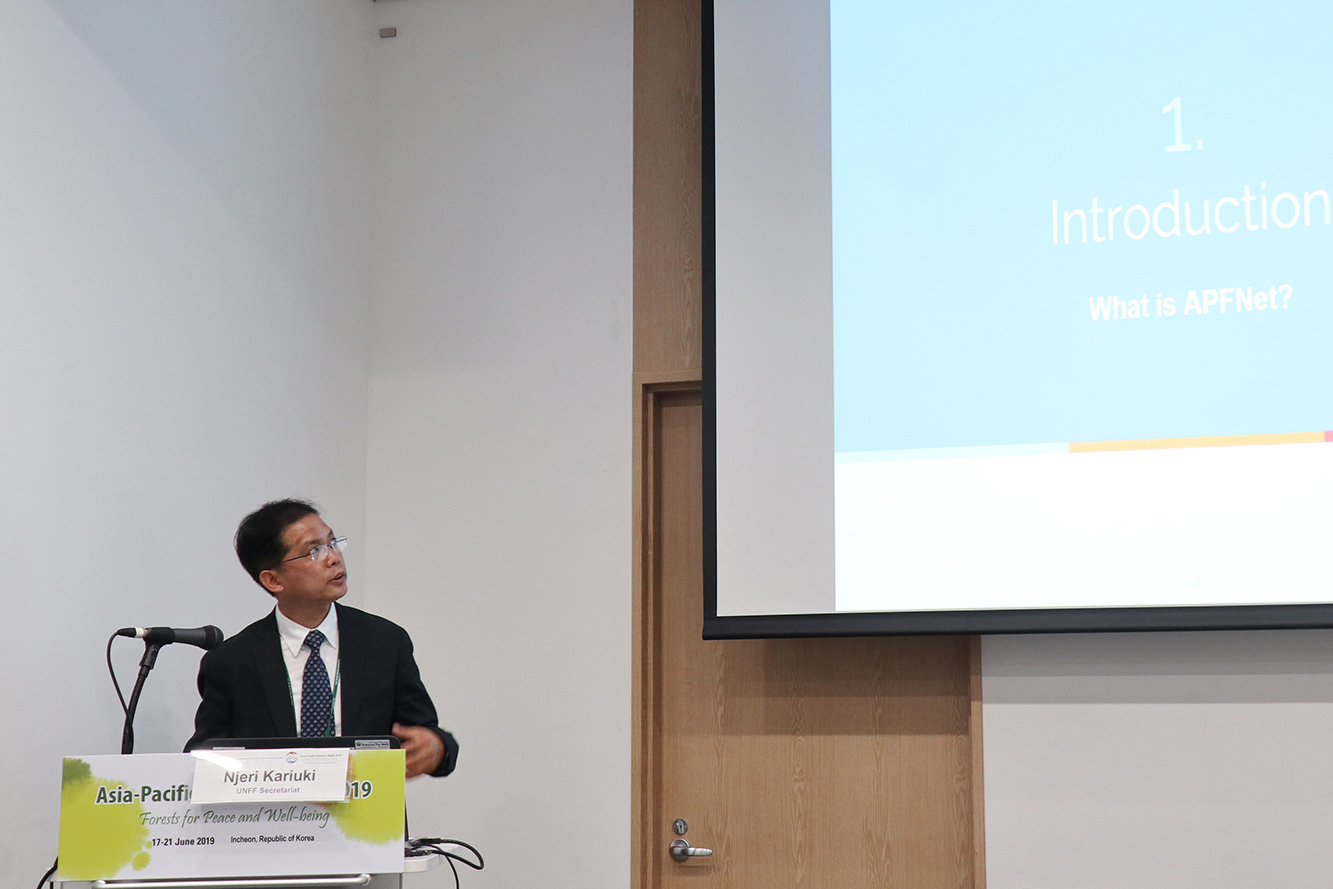Helping create sustainable landscapes for the well-being of all – APFNet at the APFW 2019
The fourth Asia-Pacific Forest Week, themed “Forests for Peace and Well-being” was held in Incheon, Republic of Korea, on 18–21 June. APFNet organized Stream 1 in collaboration with the Asian Forest Cooperation Organization (AFoCO) and the Pacific Community (SPC) titled “Restoring our forests and landscapes” – a theme strongly aligned with one of APFNet’s key priorities. Eighteen plenary and partner events were jointly shaped with 21 partner organizations, joined by around 500 participants.
The aim of Stream1 was to take stock of the state and progress of forest and landscape restoration (FLR) and to reshape restoration strategies to ensure that forests and landscapes meet our future needs. Stream events ranged from a review of the use of FLR in Asia, to the role of FLR in forest transition, to engaging the private sector in restoration, and many other topics.
At the plenary session co-organized by APFNet, AfoCO and SPC, panellists agreed that there is an unprecedented opportunity to massively upscale FLR in light of the huge surge of interest accompanying the upcoming UN Decade on Ecological Restoration, increased awareness of the importance of FLR, the knowledge that has accumulated on how to implement FLR on the ground, and emerging funding streams.
The aim of Stream1 was to take stock of the state and progress of forest and landscape restoration (FLR) and to reshape restoration strategies to ensure that forests and landscapes meet our future needs. Stream events ranged from a review of the use of FLR in Asia, to the role of FLR in forest transition, to engaging the private sector in restoration, and many other topics.
At the plenary session co-organized by APFNet, AfoCO and SPC, panellists agreed that there is an unprecedented opportunity to massively upscale FLR in light of the huge surge of interest accompanying the upcoming UN Decade on Ecological Restoration, increased awareness of the importance of FLR, the knowledge that has accumulated on how to implement FLR on the ground, and emerging funding streams.

The panellists at the APFW Stream 1 opening plenary (from left): Ms Susana Waqainabete-Tuisese, Director, Conservation International Fiji;
Mr Martin Forsen, CEO, Burapha Agro-Forestry Co. Ltd.; Dr C.T.S. Nair, Natural Resources Management Consultant;
Dr Don Koo Lee, former Minister of the Korea Forest Service; Mr W.A.C. Weragoda, Conservator General of Forests, Sri Lanka;
Mr Werner Kornexl, Senior Natural Resources Management Specialist, World Bank; and Mr Patrick Durst, moderator.
In the APFNet–IUCN event, “Making it work: forest landscape restoration experience in Asia”, a case study presented by the University of the Sunshine Coast showed that it is possible to negotiate and reach agreement through trust-building in communities, adequate social and educational preparation, and local institutional capacity building. It requires, therefore, the allocation of sufficient time and funds – before the first tree goes in the ground – for these crucial preparatory steps.
Also at this event, APFNet presented its project in Miyun,a crucial water catchment for Beijing, China, where close-to-nature forestry techniques have been employed to improve the functionality of degraded forests and shrublands in soil erosion control. Simultaneously, the project introduced new livelihood activities for local people, including forest-based ecotourism and forest therapy.
“The idea of multifunctionality is an important one. Sometimes, like in Miyun, forests may legally not be used in multiple ways, but if we look at the landscape scale, we can make sure that those multiple benefits are realized,” said APFNet project officer Anna Finke, explaining the integrated approach taken at one of the Miyun project sites.

Ms Anna Finke presents APFNet restoration projects.
An event jointly organized by the University of Melbourne and APFNet, “Engaging the private sector in forest restoration”, brought together the private sector, non-governmental organizations (NGOs) and researchers to explore approaches for overcoming policy and financial challenges and incentivizing private-sector investment. Speakers pointed out that the private sector is an underexploited – and often underappreciated – resource for helping finance and implement FLR.
Despite an overall increase in forest cover in the Asia-Pacific region in recent decades, driven largely by large-scale reforestation programmes in a few economies, additional efforts are needed to facilitate the transition process – from net forest loss to forest gain – in many other economies. Moreover, more efforts are needed to improve the ecological functioning of existing forests across the region, and this is unlikely to happen without money invested by the private sector.
The forestry asset class is worth about US$280 billion worldwide and is predicted to grow to US$1 trillion of combined production and conservation value by 2050, with increasing demand for sustainably managed products and infrastructure1. Private-sector investment in forest restoration is growing in the Asia-Pacific region, but governments, NGOs and researchers could accelerate such investment by analysing the total economic benefits, encouraging blended finance, conducting public-awareness campaigns, and providing clear, simple investment rules and consistent policies. Climate finance and payments for other ecosystem services such as biodiversity credits would generate additional income streams for restoration and thereby help make restoration financially viable at a larger scale.
Despite an overall increase in forest cover in the Asia-Pacific region in recent decades, driven largely by large-scale reforestation programmes in a few economies, additional efforts are needed to facilitate the transition process – from net forest loss to forest gain – in many other economies. Moreover, more efforts are needed to improve the ecological functioning of existing forests across the region, and this is unlikely to happen without money invested by the private sector.
The forestry asset class is worth about US$280 billion worldwide and is predicted to grow to US$1 trillion of combined production and conservation value by 2050, with increasing demand for sustainably managed products and infrastructure1. Private-sector investment in forest restoration is growing in the Asia-Pacific region, but governments, NGOs and researchers could accelerate such investment by analysing the total economic benefits, encouraging blended finance, conducting public-awareness campaigns, and providing clear, simple investment rules and consistent policies. Climate finance and payments for other ecosystem services such as biodiversity credits would generate additional income streams for restoration and thereby help make restoration financially viable at a larger scale.

Speakers at an event on engaging the private sector in forest restoration (from left): Trang Hoang, FLOURISH Project Coordinator, RECOFTC;
Mr Martin Forsen, Burapha Agroforestry Company Ltd., Lao PDR; Mr Bradford Sanders, APRIL Forestry Indonesia Ltd.;
Mr Heng Xu, China University of Political Science and Law; Professor Rod Keenan, University of Melbourne.
Forest governance is a keyfactor insustainable forest management at the national and international level. APFNet, therefore, presented on its contributions to the implementation of Global Forest Goal 5 (GFG5) in the Asia-Pacific region at an event in Stream 5. The key challenges and needs of current forestry planning had previously been identified in a baseline review of forestry strategic planning in Asia-Pacific economies under the Forestry Planning Network (FPN). At the same time, APFNet had also directly supported Fiji, Niue and Tonga to develop forest management plans respectively, and another APFNet project had supported the development of a new forest-sector policy and strategy in Nepal. Finally, a recent APFNet publication had made key recommendations on the fragmentation of forest governance in the Asia-Pacific region.

APFNet Assistant Executive Director Zhang Zhongtian speaks on forest governance.
Building on the outcomes of the series of events organized by APFNet and its partners in Stream 1, APFNet recommends that economies in the Asia-Pacific region scale up their forest restoration efforts as a means to significantly enhance human well-being by
• mainstreaming FLR into ongoing national development and environmental policy processes
• encouraging the private sector to adopt FLR principles and practices in their reforestation investments by:
- providing fiscal and other incentives;
- increasing transparency in policies and laws affecting land use;
- developing and disseminating FLR tools and knowledge;
- ensuring a level playing field among land uses; and
- resolving conflicts over landtenure.
APFNet illustrated its work across the region’s landscapes in a booth set up in the exhibition centre for the duration of APFW 2019. The booth, which boasted a magnificent painting of an idealized landscape, was designed to show the audience that forest and other ecosystems are essential components of human well-being.
• mainstreaming FLR into ongoing national development and environmental policy processes
• encouraging the private sector to adopt FLR principles and practices in their reforestation investments by:
- providing fiscal and other incentives;
- increasing transparency in policies and laws affecting land use;
- developing and disseminating FLR tools and knowledge;
- ensuring a level playing field among land uses; and
- resolving conflicts over landtenure.
APFNet illustrated its work across the region’s landscapes in a booth set up in the exhibition centre for the duration of APFW 2019. The booth, which boasted a magnificent painting of an idealized landscape, was designed to show the audience that forest and other ecosystems are essential components of human well-being.

Members of a high-level delegation that visited APFNet’s booth (from left): Mr Ben Gunneberg, Secretary General, PEFC;
Mr Park Nam-Choon, Mayor of Incheon; Mr Kim Jae-Hyun, Minister of Korea Forest Service;
Ms Kundhavi Kadiresan, FAO Assistant Director-General; Ms Siti Nurbaya Bakar, Minister of Environment and Forestry of Indonesia;
and advisor to the minister, Ministry of Environment and Forestry of Indonesia.
Mr Park Nam-Choon, Mayor of Incheon; Mr Kim Jae-Hyun, Minister of Korea Forest Service;
Ms Kundhavi Kadiresan, FAO Assistant Director-General; Ms Siti Nurbaya Bakar, Minister of Environment and Forestry of Indonesia;
and advisor to the minister, Ministry of Environment and Forestry of Indonesia.
1https://www.forest-trends.org/blog/a-financial-architecture-for-global-carbon-sinks-a-new-forestry-investment-strategy/



